Sericulture: the cultivation of silk for production of silk fabrics and textiles
Silk is a natural protein fiber and the best-known silk is obtained from the cocoons of the larvae of mulberry silkworms. Silk for production of silk fabric comes from pupae that are bred to produce a white coloured silk thread. There are several commercial species but the Bombyx mori is the most widely used.

As a child we used to keep silk worms in a shoe box and the lid had holes poked into it to give the worms fresh air. Every day after school we used to pick fresh mulberry leaves from the tree in the garden to feed them. We were always amazed by how quickly the worms grew. Sometime we cut cardboard shapes like hearts or circles for the worms to spin on. Commercial cultivation for production of silk fabric is very controlled today.
Producing silk is a lengthy process and needs to be monitored closely. To produce high quality silk there are 2 conditions that must be met:
- The pupae must not hatch.
- The worms must eat a perfect diet.
China is the main producer of silk and for many centuries the Chinese kept the techniques and processes of sericulture a secret. Anybody smuggling eggs or cocoons out of China or revealing the secrets of sericulture, would be sentenced to death.
The main steps involved in sericulture are 1) Rearing the silkworms and 2) Processing the cocoon to obtain silk fibers.
1. Silk Cultivation – Rearing Silkworms
The female moth lays hundreds of eggs at a time. In commercial cultivation the silk moths lay eggs on specially prepared paper and the eggs are kept at controlled temperatures to ensure that they hatch. After the eggs have hatched, the caterpillars, known as silk worms, are fed fresh mulberry leaves throughout the day and night. 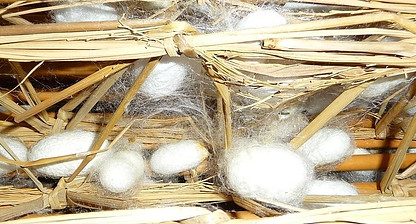
The caterpillars grow very quickly and after about 35 days and 4 moltings (shedding their outer layer), the silk worms are 10,000 times heavier than when they hatched.
They are now ready to start spinning cocoons and a straw frame is placed over the trays in which the caterpillars are kept.
The caterpillar has two silk glands that produce liquid silk. This is forced through openings, called spinnerets, in the head of the silkworm. The liquid silk is coated by a water-solluble protective gum called Sericin, which solidifies when it comes into contact with air. Each caterpillar will spin about 600 to 900 meters of filament within 2 to 3 days, totally encasing the worm in a cocoon that looks like a puffy white ball.
2. Processing The Cocoons
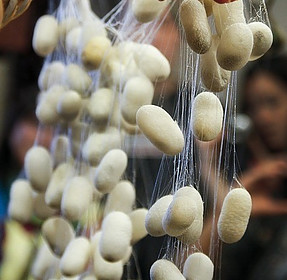
Silk cocoons are kept in a warm dry place and after eight to nine days, the cocoons are ready to be unwound. The harvested cocoons are heated to kill the pupae before the moths can emerge from the cocoon.
Silk cocoons are then soaked in boiling water to soften the sericin that is holding the silk in a cocoon shape, making it possible to unravel the silk fibers of the whole cocoon as one continuous thread.
These threads are very fragile and thin so 3 to 10 threads are spun together to form a single thread of silk. The silk fabric that can be woven from these threads are stronger than wild silk.
Silk farmers will keep some cocoons to metamorphose into moths for the next cycle of silk worms.
Sorting Of Cocoons
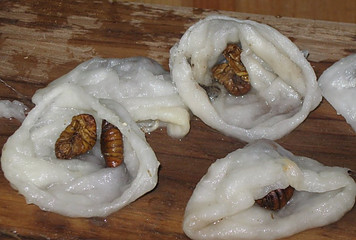 Cocoon sorting is done to separate and eliminate any defective cocoons, which would include double or twin cocoons, and any that are pierced, immature, flimsy, pointed or constricted. These cocoons would lower the quality of silk fabric and have alternatives uses within the silk industry.
Cocoon sorting is done to separate and eliminate any defective cocoons, which would include double or twin cocoons, and any that are pierced, immature, flimsy, pointed or constricted. These cocoons would lower the quality of silk fabric and have alternatives uses within the silk industry.
Double or twin cocoons are spun by two worms. They are difficult to process as they do not unwind smoothly and tangle easily as the threads are intertwined. They cannot be twined with single cocoons and are used to manufacture a coarse yarn called “dupion”. Double or twin cocoons are also stretched to make duvets, pillows and comforters. 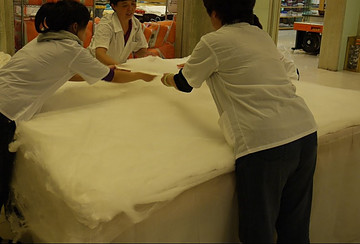
The double silk cocoons are opened to remove the pupae and other waste and then soaked to soften them. The softened cocoons are then stretched over a frame.
A series of different sized frames are used, each stretching the cocoon to be bigger and to form a flattened dome of silk. Finally four people will pull it gently to put it over a frame the size of a bed. Numerous layers are built up to form wadding for making a duvet or comforter. This silk wadding is then covered with fabric.
I saw this silk stretching being done at a silk factory in Beijing and was fortunate enough to buy a silk duvet. Our silk duvet is light and warm and ideal to use all year round. Silk duvets and pillows are naturally hypoallergenic and brilliant for use by asthma and other allergy sufferers..
Different Types Of Silk Yarn
4 different types of silk yarns are produced by silk manufacturers
- Thrown singles – Two strands of silk are twisted in one direction and these are used for sheer fabrics.
- Tram – Multiple strands are twisted in one direction and these are used for the weft.
- Crepe – Raw silk threads are twisted and then doubled and twisted again and these are used for crinkly fabrics.
- Organzine warp threads – raw silk is twisted in one direction and then two strands are twisted together in the opposite direction. These are then used for the warp in weaving silk fabric
Wild silk is produced by caterpillars other than the mulberry silkworms. The production of wild silk fabric has always been much smaller than cultivated silks. There are several reasons for that:

- The colour and texture differ from the cultivated varieties and are therefore not as uniform. Wild silk has natural bumps in the filaments and has little to no sheen.
- The pupae that live in the cocoons have normally left the cocoons that are gathered in the wild. This means that the silk threads have been torn resulting in shorter lengths.
- Many wild cocoons have a mineral layer on the outside that makes it very difficult to reel long strands of silk thread from them. The mineral layer can be removed through a process of demineralisation so that the silk thread can then be removed.
- Wild silk tends to be more difficult to dye than cultivated silk.
- Due to the extra hand work involved in collecting and processing the wild cocoons, wild silk is normally more expensive than cultivated silk fabric.
- In northern Madagascar wild silk is providing sustainable living for local people, giving them income without destroying natural resources.
The Properties Of Silk Fabric
- Silk fabric looks lustrous and luxurious and has a beautiful drape.
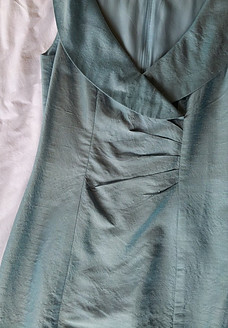 It has often been called the queen of fabrics and has been used for making high-end garments and household products for many years.
It has often been called the queen of fabrics and has been used for making high-end garments and household products for many years. - Silk is the strongest natural fiber and it has a good tensile strength.
- Being protein in nature, silk fabric has good absorbency. It is comfortable to wear in warm weather and while active and warm to wear in cool weather.
- Silk fabric is a low conductor of heat – it keeps warm air close to the skin during cold weather.
- The smooth surface of silk means that it doesn’t easily attract dirt. Dirt can be removed by gentle washing or dry cleaning. Avoid agitation and use a mild soap when cleaning it.
- Practical use – excellent for clothing that will protect from insect bites like mosquitoes and horseflies that would pierce ordinary clothing.
- Sunlight and perspiration will weaken the fiber and make it yellow, so if worn next to the body, washing and cleaning is recommended after each wear.
- Silk fabric is naturally resistant to moths and mites.
Caring and Cleaning Your Silk Duvet
Always use a duvet cover with any duvet to protect the duvet and prevent soiling.
When I bought my silk duvet, I was advised that regular airing of the duvet will mean that it doesn’t need to be washed. Silk is naturally hypoallergenic, which means that it is free of dust mites. Airing the duvet outside for two to three hours on a sunny day, two to three times per year, is all that is required. This has the effect of cleaning and purifying the delicate silk fibers.
Localised spillages must be wiped immediately and if any of the spillage did penetrate into the silk duvet, just wash that spot with luke warm water, no more than 30°C, and use natural or non-biological detergent.
A silk duvet should never be dry cleaned as the chemicals that are used during the process, will damage the silk.
Read more about the reasons for choosing a silk filled duvet in this related post: Why Choose a Mulberry Silk Filled Duvet?
Food For The Silkworm
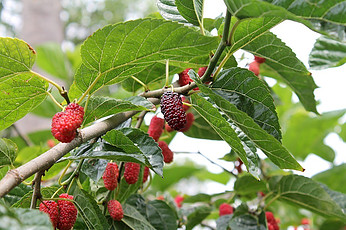 Growing Mulberry trees are important as the silkworm feeds exclusively on the leaves. Mulberry trees are grown throughout Asia and many other parts of the world. Leaves from plantation grown mulberry trees are plucked and chopped to feed silkworms.
Growing Mulberry trees are important as the silkworm feeds exclusively on the leaves. Mulberry trees are grown throughout Asia and many other parts of the world. Leaves from plantation grown mulberry trees are plucked and chopped to feed silkworms.
Trees are also cultivated for the delicious fruit – mulberries. Any surplus mulberry production can also be used for feeding other animals.
Silk is a principal part of the Chinese economy and China is still the main producer of silk fabric. India is the second largest producer and together they produce more than 90 percent of global production. Thailand and Japan are also big producers of silk fabric.
Although the silkworm is killed during the process of sericulture, they can be eaten. The moths can be left to hatch with the silk being collected afterwards. The silk would be used to make silk shantung.
- If you live in the US: this is where you can buy a silk duvet
- If you live in the UK or EU: this is where you can buy a silk duvet
I hope you have enjoyed learning about sericulture and production of silk. If you have any questions or comments, please leave them below and I would be happy to get back to you.

Nice Article ??? ??
Thank you
Your post was so interesting. I never actually knew where silk came from, how it was cultivated and how much work goes into the production of it. it’s actually quite fascinating! you mentioned about silk garments needing gentle cleaning after wearing and that a silk duvet is good due to it’s ability to maintain temperature. I was just wondering the best way to keep a duvet clean. would you recommend dry cleaning?
Hi Amy,
A silk duvet should never be dry cleaned as the chemicals will damage the silk. When I bought my silk duvet, I was advised that regular airing of the duvet will mean that it doesn’t need to be washed. Silk is naturally hypoallergenic, which means that is is free of dust mites.
Airing the duvet outside for two to three hours on a sunny day, two to three times per year, is all that is required. This has the effect of cleaning and purifying the delicate silk fibers.
Localised spillages must be wiped immediately and if any of the spillage did penetrate into the silk duvet, just wash that spot with luke warm water, no more than 30°C using non-biological detergent.
I hope this helps, Liné
I have heard that silk comes from worms but never really knew how the process goes, interesting! So just to make sure that I got it right, the silk comes from the worms’ cocoons, right? Wow a genius plan whoever discovered that is a godsend, I would have never checked worms for silk threads even if it was some 2,000 years back.
Yes Riaz, the silk comes from the cocoons spun by the silkworms. There is a story that it was discovered how to get the silk when a cocoon fell into the teacup of a princess sitting under the tree. The heat from the tea made the cocoon soft and she realised that it could then come loose.
Hi there,
Wow, this was a very informative article. I really enjoyed the reading!
I love so much silk that I have called my daughter silk:)
Anyway, I learned a lot about how silk is made and I thank you for it!
I would never have guessed that silkworm eats mulberry. Do they also eat all sorts of insects?
It’s a bit sad the way the silkworm die. What I am sure about is that I would never be able to make silk fabric.
Thank you for this excellent post!
Hi Daniella, silkworms only eat the leaves from mulberry trees, no insects or anything else.
Hi
Thank you so much for sharing this post. I have used silk clothes but didn’t know the details about how it being cultivated. Your post was really interesting and now I have known the cultivation process of silk after reading your post. You said details about cocoons and also have mentioned different kinds of silk and gave a description. I never knew that it has often been called the queen of fabrics. You have also mentioned how to clean up this cloths.
Your post was so much informative and I have learned many unknown things through your post.
Thank you so much.
I am pleased that you enjoyed learning about silk
Very interesting topic! Is the production of silk still done by hand or do they use machinery for handing the fine fibres? I find it amazing that silk is one of the original fibres from centuries ago, and is as much a luxury item then as it is now. I didn’t realise it was also useful for different temperatures, being a fine textile, I assumed it was just for warm weather, so I learnt something new there.
Hi Pam, some stages would be done by hand and much of the production of twining, the yarns and weaving is done by machine